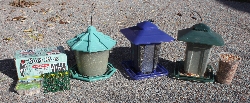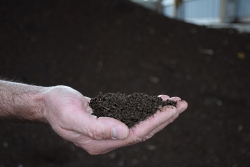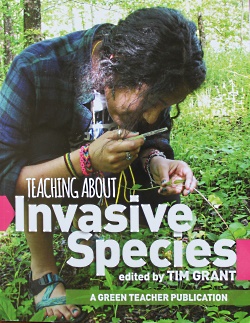
Courtesy Ron Hellstern, photographer
Presenting “gifts” of birdfeeders and seeds to others (and your own family) will help songbirds and fowls to survive so they can provide their songs and beauty in the Spring. Consider these tips:
- Buy large birdfeeders so you don’t have to fill them so often. Wet seed can grow harmful bacteria, so use feeders with wide covers.
- If deer, or other pests, invade your feeders, hang them up higher in trees.
- Place feeders 10’ away from dense cover to prevent sneak attacks from cats.
- Provide multiple feeders to increase amounts and diversity of foods.
- “Favorite” winter foods depends on the species. Black Oil sunflower seeds are loved by most birds, but niger, millet, peanuts, corn, and wheat will attract a diverse range of birds. Experiment and see what comes to your feeders.
- A combination of beef-fat, with seeds or fruit, is called suet. It is a high-energy food which helps birds stay warm. The 4” cakes are placed in small cages and are loved by flickers, woodpeckers and many other birds. Peanut butter is also relished by birds, but is more expensive than suet.
- Once birds find your feeders, they will rely on them for regular food supplies. If your feeders become empty, especially during ice storms or blizzards, birds will have a hard time finding natural food. If you take a trip, have a neighbor keep your feeders filled.
- Buy extra seed and store it in a cool, dry place like a covered plastic trash can which can be kept on a deck, porch, or in a garage.
- Make sure the feeders are kept clean with hot water, and then dried, about once a month.
- Some birds, like juncos, towhees, doves and pheasants prefer eating seed which has fallen to the ground. Compact the snow below your feeders so they can find that seed easier.
- Unless you live near a natural water source, place a pan of water near a feeder on warmer days. Or you could consider a heated bird bath to provide drinking water.
- If you have fruit trees or berry bushes, leave some of the fruit on the plants to provide natural foods.
- You may wish to leave birdhouses and nest-boxes up all year for winter roosting sites.
Now the fun part comes. After your feeders have been discovered by some birds, word soon gets around the neighborhood and others will arrive. But do you know what they are? The Peterson Field Guidebooks are a great help for beginners because the illustrations are often grouped by color. Then you can become a citizen-scientist and submit your observations to Cornell’s Project Feederwatch or participate in the Great Backyard Bird Count each December. Look online for details.
Time to get started with your own feeders, or as gifts to others, and begin enjoying the colorful company of finches, woodpeckers, towhees, juncos, sparrows, doves and many others.
Credits:
Images: Courtesy & Copyright Ron Hellstern, Photographer
Audio: Contains bird audio Courtesy & Copyright Kevin Colver
Text: Ron Hellstern, Cache Valley Wildlife Association
Additional Reading
Feed the Birds, Jim Cane & Linda Kervin, Wild About Utah, Bridgerland Audubon Society, Dec 1, 2011, https://wildaboututah.org/tag/feeding-birds/
Winter Song Birds, Jim Cane & Linda Kervin, Wild About Utah, Bridgerland Audubon Society, Feb 3, 2009, https://wildaboututah.org/tag/feeding-birds/
Audubon Guide to Winter Bird-Feeding, Steve Kress, Audubon Magazine, Nov-Dec, 2010, https://www.audubon.org/magazine/november-december-2010/audubon-guide-winter-bird-feeding
Backyard Birding, Bird Feeding, US Fish & Wildlife Service(FWS), Last Updated: February 19, 2016, https://www.fws.gov/birds/bird-enthusiasts/backyard/bird-feeding.php
Backyard Birding, Helping our Feathered Friends, US Fish & Wildlife Service(FWS), Last Updated: June 1, 2016, https://www.fws.gov/birds/bird-enthusiasts/backyard/songbird-conservation.php
Backyard Bird-Feeding Resources, Birds at Your Feeder, Erica H. Dunn, Diane L. Tessaglia-Hymes, Project Feederwatch, https://feederwatch.org/learn/articles/backyard-bird-feeding-resources/




